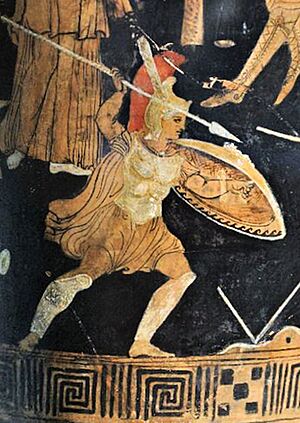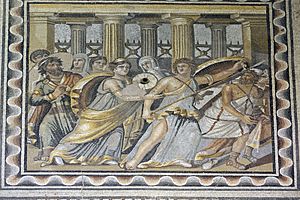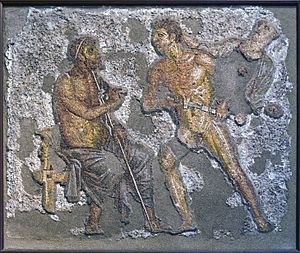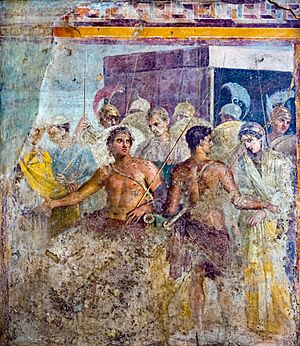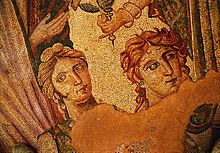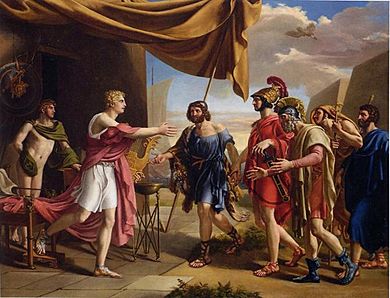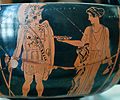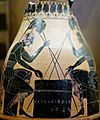Achilles facts for kids
In Greek mythology, Achilles (pronounced "uh-KIL-eez") was a famous hero of the Trojan War. He was known as the greatest of all the Greek warriors. He is the main character in Homer's epic poem, the Iliad. Achilles was the son of Thetis, a sea goddess (called a Nereid), and Peleus, who was the king of a place called Phthia.
Achilles' most famous act during the Trojan War was killing the Trojan prince Hector right outside the city gates of Troy. Even though the Iliad doesn't describe Achilles' death, other stories say he was killed near the end of the war. He was shot with an arrow by Paris.
Contents
What's in a Name?
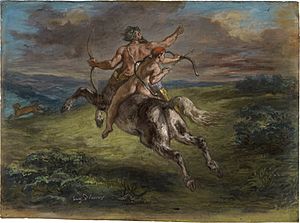
The name Achilles comes from two Greek words. One word means "distress" or "pain," and the other means "people" or "soldiers." So, his name can mean "he who causes distress to the people" or "he whose people are in distress." This idea of distress or grief for his people is a big theme in the Iliad. Sometimes, Achilles' actions cause pain to his enemies. But other times, his own people suffer because of his choices.
Other Names for Achilles
Achilles was known by several other names, including:
- Pyrisous: This means "saved from the fire." It relates to a story where his mother tried to make him immortal by fire.
- Aeacides: This name comes from his grandfather, Aeacus.
- Pelides: This name comes from his father, Peleus.
- Phthius: This name comes from his birthplace, Phthia.
- Podarkes: This means "swift-footed." It refers to how fast he was.
How Achilles Was Described
Ancient writers described Achilles as a strong and handsome man. He had a large chest and powerful arms and legs. His head was covered with long, wavy, chestnut-colored hair. Even though he was gentle in his manners, he was very fierce and brave in battle. Homer, a famous Greek poet, also described Achilles as having blond hair.
His Special Weakness
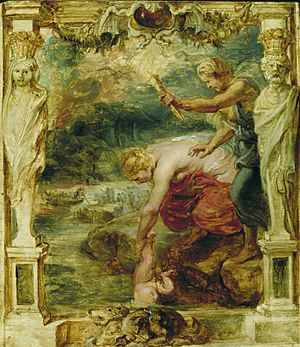
Later legends, starting around the 1st century AD, say that Achilles was almost impossible to harm. The story goes that when he was a baby, his mother, Thetis, dipped him in the magical river Styx. This made his body invulnerable, meaning he couldn't be hurt. However, she held him by one heel, so that part of his body was not touched by the water. This left his heel as his only weak spot.
Because of this legend, we now use the phrase "Achilles' heel" to mean a weak point in someone or something that is otherwise very strong. Also, the "Achilles tendon" in your ankle is named after him because of this story.
It's interesting to note that older stories, like Homer's Iliad, don't mention Achilles being invulnerable. In fact, Homer describes Achilles getting wounded. In early vase paintings that show Achilles' death, arrows often hit his body, not just his heel.
Birth and Early Life
Achilles was the son of Thetis, a sea goddess, and Peleus, the king of the Myrmidons. The gods Zeus and Poseidon both wanted to marry Thetis. But a prophecy said that Thetis would have a son who would be even greater than his father. Because of this, Zeus and Poseidon decided not to marry her. Instead, they arranged for her to marry Peleus.
Peleus sent Achilles to be raised by Chiron, a wise Centaur (a creature that is half-human, half-horse). Chiron lived on Mount Pelion. Thetis knew that her son had two possible fates: he could become very famous and die young, or he could live a long but ordinary life. Achilles chose to become famous, which meant he would fight in the Trojan War. Homer's stories say that Achilles grew up in Phthia with his close friend, Patroclus.
Hidden on Skyros Island
Some stories written after Homer's time say that Thetis tried to keep Achilles safe from the Trojan War. She hid him on the island of Skyros. There, Achilles dressed as a girl and lived among the daughters of King Lycomedes. He might have used the name "Pyrrha."
While on Skyros, Achilles had two sons with Lycomedes' daughter, Deidamia. One of his sons was named Neoptolemus. The Greek hero Odysseus found out that the Greeks needed Achilles to win the war. So, Odysseus went to Skyros disguised as a peddler selling women's items. He placed a shield and a spear among his goods. When Achilles immediately grabbed the spear, Odysseus knew who he was and convinced him to join the war. In another version, Odysseus set off a trumpet alarm. While the other women ran in fear, Achilles prepared for battle, showing his true identity.
In the Trojan War
According to the Iliad, Achilles arrived at Troy with 50 ships. Each ship carried 50 of his brave warriors, called Myrmidons. He had five leaders for his army.
Achilles in the Iliad
Homer's Iliad tells the most famous story of Achilles' actions in the Trojan War. The main theme of the poem is Achilles' great anger. The poem begins by talking about "the rage of Peleus' son Achilles."
The Iliad only covers a few weeks of the ten-year war. It doesn't tell the story of Achilles' death. The poem starts with Achilles refusing to fight. This happens after he is disrespected by Agamemnon, the leader of the Greek forces. Agamemnon had taken a woman named Chryseis as his slave. Her father, a priest of Apollo, asked Agamemnon to return her. Agamemnon refused, so Apollo sent a terrible plague on the Greeks.
A prophet named Calchas figured out why the plague was happening. He said Chryseis had to be returned. Agamemnon agreed, but then he took Achilles' war prize, a woman named Briseis. Achilles was furious that his honor and prize were taken. His mother, Thetis, convinced Zeus to help the Trojans win battles. This was so Achilles could get his honor back.
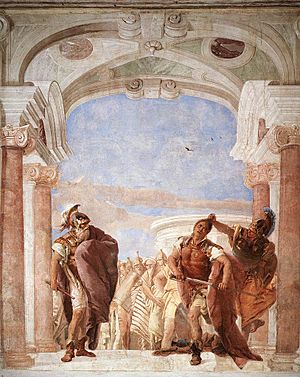
As the war turned against the Greeks, Nestor said it was because Agamemnon had angered Achilles. He urged Agamemnon to make peace with Achilles. Agamemnon offered to return Briseis and give Achilles many gifts. But Achilles refused everything. He told the Greeks to just sail home, as he planned to do.
The Trojans, led by Hector, pushed the Greek army back to their ships. The Greeks were almost completely defeated. At this point, Patroclus, Achilles' close friend, led the Myrmidons into battle. He wore Achilles' armor. Patroclus managed to push the Trojans back, but he was killed by Hector.
When Achilles heard about Patroclus's death, he was filled with deep sadness and rage. His mother, Thetis, came to comfort him. She asked Hephaestus, the god of fire and metalworking, to make new armor for Achilles. This new armor included the famous Shield of Achilles, which is described in great detail in the poem.
Filled with anger over Patroclus's death, Achilles decided to fight again. He killed many men, always looking for Hector. He even fought against the river god Scamander, who was angry because Achilles was filling his waters with dead bodies. The god tried to drown Achilles, but was stopped by other gods.
Finally, Achilles found Hector. Achilles chased Hector around the walls of Troy three times. Then, the goddess Athena tricked Hector into stopping and fighting Achilles face-to-face. Hector realized he was tricked and knew he would die. He begged Achilles to treat his body with respect after killing him. Achilles refused. After killing Hector, Achilles dragged his body behind his chariot.
Later, Achilles held special funeral games to honor Patroclus. With help from the god Hermes, Hector's father, Priam, went to Achilles' tent. Priam begged Achilles to return Hector's body so he could be properly buried. Achilles finally agreed and promised a truce for nine days for the funeral. The poem ends with a description of Hector's funeral. The fates of Troy and Achilles himself were still to come.
How Achilles Was Honored
Achilles' tomb was a famous place in ancient times. People from Thessaly and even Persian armies visited it. Alexander the Great and the Roman emperor Caracalla also honored Achilles at his tomb. Achilles was also worshipped in other places, like on the island of Astypalaea and in cities like Sparta and Tarentum.
The kings of Epirus said they were related to Achilles through his son, Neoptolemus. Alexander the Great, whose mother was an Epirote princess, could also claim this connection. Alexander tried to be like Achilles in many ways. He visited Achilles' tomb when he passed by Troy.
Achilles in Modern Stories and Art
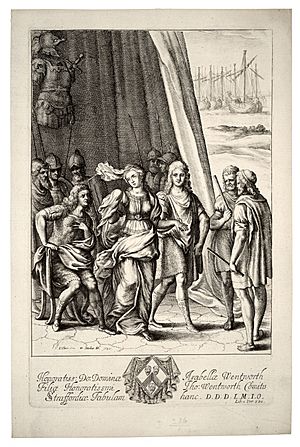
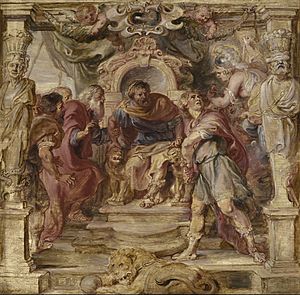
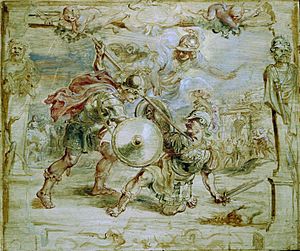
Achilles has appeared in many modern books, plays, songs, and movies.
Literature
- Achilles is in Dante's Inferno (written 1308–1320).
- He is a character in William Shakespeare's play Troilus and Cressida (1602).
- The novel The Song of Achilles (2011) by Madeline Miller tells the story of Achilles and Patroclus.
Visual Arts
- Many artists have painted scenes from Achilles' life. Anthony van Dyck and Nicolas Poussin painted "Achilles with the Daughters of Lycomedes."
- Peter Paul Rubens created a series of works about Achilles' life, including "Thetis dipping the infant Achilles into the river Styx" and "The death of Hector."
- "The Rage of Achilles" is a famous fresco by Giovanni Battista Tiepolo (1757).
Music
Achilles has inspired many operas and ballets:
- Operas called Deidamia were composed by Francesco Cavalli (1644) and George Frideric Handel (1739).
- Achilles Last Stand is a song on the 1976 Led Zeppelin album Presence.
- Achilles Come Down is a song by Gang of Youths (2017).
Film and Television
Achilles has been shown in several films and TV series:
- In the 1956 film Helen of Troy, he was played by Stanley Baker.
- In the 2004 film Troy, he was played by Brad Pitt.
- In the 2018 TV series Troy: Fall of a City, he was played by David Gyasi.
Buildings Named After Achilles
- In 1890, Empress Elisabeth of Austria built a summer palace in Corfu. She named it the Achilleion after Achilles. The building has paintings and statues showing scenes from the Trojan War.
- The Wellington Monument in London is a statue of Achilles. It was built in 1822 to honor the Duke of Wellington and his military victories.
Other Things Named After Achilles
- Several ships of the Royal Navy have been named HMS Achilles. One famous ship, HMNZS Achilles, fought in the Battle of the River Plate during World War II.
- A type of lizard, Anolis achilles, is named after him because it has wide heel plates.
Images for kids
-
The embassy to Achilles, from an Attic red-figure hydria (a water jar), around 480 BC.
-
Achilles praying to Zeus for Patroclus to return safely. This is from the Ambrosian Iliad, an old illuminated manuscript from the 5th century.
-
Achilles killing Penthesilea, from a red-figure kylix (a drinking cup), around 465 BC.
-
Thetis and the Nereids mourning Achilles, from a Corinthian black-figure hydria, around 555 BC.
-
Achilles and Ajax playing a board game called petteia, from a black-figure oinochoe (a wine jug), around 530 BC.
-
The head of Achilles shown on a 4th-century BC coin from Kremaste. The other side shows Thetis holding Achilles' shield.
See also
 In Spanish: Aquiles para niños
In Spanish: Aquiles para niños


